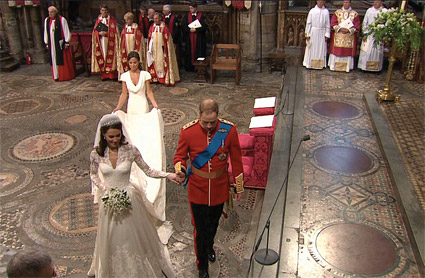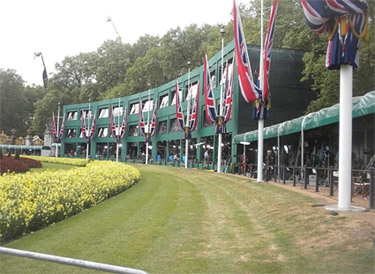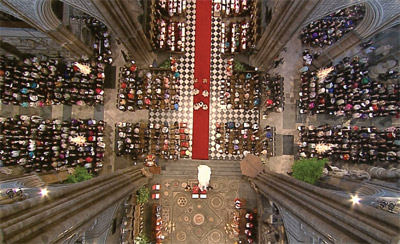Royal Wedding a Mega-Event for TV
LONDON—Two billion people—that's how many TV viewer worldwide were estimated to have watched the royal wedding of Prince William and Kate Middleton on April 29. In the United States alone, 22.8 million viewers tuned in. Many more saw the story both before and after the event.

Photo by BBC Collectively, this gigantic audience made the royal wedding a true television "mega-event" —and justified the incredible efforts that TV networks made to cover it.
The most important location for royal wedding coverage was a three-story, 30-studio temporary complex built in Green Park, London. Located directly across from Buckingham Palace, the Green Park facility featured enclosed studios and standup areas for both British and foreign media. Behind the three story complex were two vehicle/SNG staging areas. The first closest was used by U.K. media; the second was given over to the foreign press.
Most broadcasters used SNG and mobile production trucks, however, NBC opted to bring in equipment packed in hardened cases from New York and supplemented by equipment sourced from its London bureau. "We shipped over 1,600 cases of equipment," says Leonard Venezia, NBC-Universal's vice president of Field Operations & Engineering. This equipment was distributed among four NBC locations: NBC's London bureau, Green Park, Trafalgar Square and Methodist Central Hall in Westminster.
The next important venue was Westminister Abbey itself. Camera positions were set up in the church, and across the street at the Methodist Central Hall. "We couldn't physically add power locations to this historic building, so the media had to bring in twin 350 kilowatt generators," says David Fairweather, CBS News' director of operations Europe. "A lot of MPs live around the Methodist Central Hall, so we had to use super-silent generators; the kind normally found on movie sets." He estimates that the Green Park complex consumed 8.6 megawatts of power.
Beyond these central locations, the networks selected their own sites to anchor a week's worth of broadcasts. CBS News set up shop at the Tower of London, while NBC camped out at Trafalgar Square. Associated Press Televison News (APTN), with more than 700 TV networks to feed worldwide, set up an editing operation at New Zealand House, plus presentation positions for clients at Buckingham Palace and Westminster Abbey.
LOGISTICS

The most important location for coverage was a three-story, 30-studio temporary complex built in Green Park, located directly across from Buckingham Palace. Each network used an arsenal of high definition cameras to cover the event. "Our HD weapon of choice is the Panasonic P2," said Sandy MacIntyre, APTN's vice president and director of news. "We used Sony HDC-1500s for our fixed cameras, but used the Sony XDCAM PDW-700s and a couple of EX-3 cameras for our 16 ENG crews," said CBS' Fairweather. Over at NBC, "our EJ crews were using Sony HDW-F900s and HDC-1550s," Venezia says. There was also a range of jib, remote, mobile and LiveU wireless-connected cameras deployed.
In addition to its regular royal wedding coverage, APTN had a second video crew standing by if the happy event suddenly became tragic. "We feared that a terrorist attack or protest could occur," says Derl McCrudden, APTN's head of newsgathering. "In readiness for that, we had a number of drivers and camerapeople with LiveU uplink packs on motor bikes, ready to head out at a moment's notice."
Each of the networks had some degree of editing capacity onsite. Because of its multi-client base, APTN did the most editing; putting out 85 different stories running up to the wedding, and 35 on the actual day. Meanwhile, although CBS and NBC did do some editing in London, they shipped most of their content back to New York for live switching and packaging.
Whenever possible, the networks used cellular and satellite links to get video from roving cameras. However, sometimes the only solution was to rely on "sneakernet," as APTN did. "Some of our people were in the crowd, and not in a position either to move or transmit," McCrudden explains. "So we had runners who grabbed the camerapeople's P2 cards and ran them back to the nearest transmission/editing points."

The royal wedding drew an estimated 2 billion viewers worldwide. Worth noting: Rather than spend more than $390,000 on six conventional HD-SDI video lines, NBC instead moved all its video over gigabit IP networks. Using nine Cisco Digital Content Manager units to manage the feeds, NBC managed to cut its signal transportation costs down to just under $41,000.
"Using the IP networks, instead of conventional HD-SDI video lines, NBC was able to distribute more than 40 HD feeds to New York and approximately another 30 around the U.S.," Venezia says. "We certainly didn't suffer in terms of speed: At one point we transmitted 96 minutes of HD video in just 32 minutes."
Meanwhile, "We used both satellite and 100 MB fiber data paths for live video over IP from both Canada Gate and Methodist Central hall to give us full redundancy," says CBS' Fairweather. "In fact, we used the fiber connectivity as our primary source as it has lower latency than satellite."
Despite extremely tight security, massive crowds, and an incredible workload, all three networks report that the wedding went off without any serious hitches. The result was a week of HD broadcasts covering this mega-event from many angles and venues; both in real-time and on server.
"The toughest part was coping with temperatures inside the small Green Park studios on wedding day," Fairweather said. "Because of outside noise, we had to keep the doors closed. The result was that the inside studio temperature went as high as 110 degrees—even with portable air conditioning!"
Get the TV Tech Newsletter
The professional video industry's #1 source for news, trends and product and tech information. Sign up below.
James Careless is an award-winning journalist who has written for TV Technology since the 1990s. He has covered HDTV from the days of the six competing HDTV formats that led to the 1993 Grand Alliance, and onwards through ATSC 3.0 and OTT. He also writes for Radio World, along with other publications in aerospace, defense, public safety, streaming media, plus the amusement park industry for something different.

